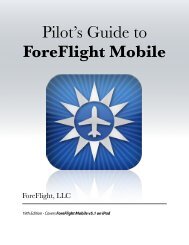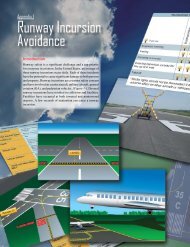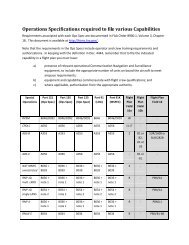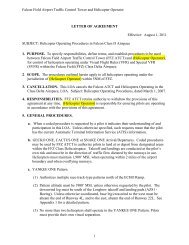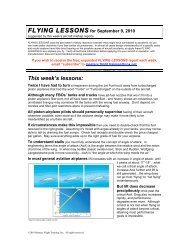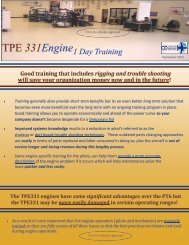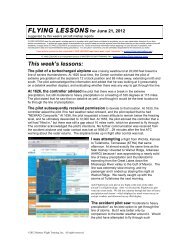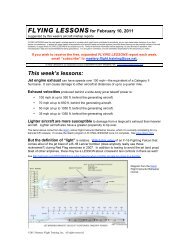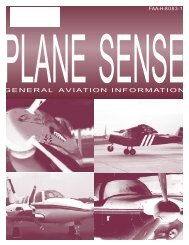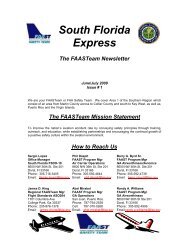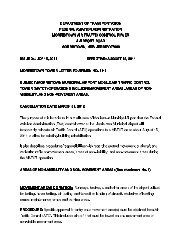110825 FLYING LESSONS.pdf - FAASafety.gov
110825 FLYING LESSONS.pdf - FAASafety.gov
110825 FLYING LESSONS.pdf - FAASafety.gov
You also want an ePaper? Increase the reach of your titles
YUMPU automatically turns print PDFs into web optimized ePapers that Google loves.
<strong>FLYING</strong> <strong>LESSONS</strong> for August 25, 2011<br />
suggested by this week’s aircraft mishap reports<br />
<strong>FLYING</strong> <strong>LESSONS</strong> uses the past week’s mishap reports to consider what might have contributed to accidents, so you can make better decisions if you face<br />
similar circumstances. In almost all cases design characteristics of a specific make and model airplane have little direct bearing on the possible causes of aircraft<br />
accidents, so apply these <strong>FLYING</strong> <strong>LESSONS</strong> to any airplane you fly. Verify all technical information before applying it to your aircraft or operation, with<br />
manufacturers’ data and recommendations taking precedence. You are pilot in command, and are ultimately responsible for the decisions you make.<br />
If you wish to receive the free, expanded <strong>FLYING</strong> <strong>LESSONS</strong> report each week, email “subscribe” to mastery.flight.training@cox.net.<br />
<strong>FLYING</strong> <strong>LESSONS</strong> is an independent product of MASTERY FLIGHT TRAINING, INC. www.mastery-flight-training.com<br />
This week’s lessons:<br />
In last week’s <strong>FLYING</strong> <strong>LESSONS</strong> we discussed the significant, negative performance<br />
impact of taking off and landing with a tailwind. Using Cessna and Beechcraft performance<br />
charts as examples, we postulated that tailwinds have a roughly three to five times greater impact<br />
on takeoff and landing performance, negatively, than do headwinds improve takeoff performance.<br />
In other words, a little headwind helps a little, but a little tailwind hurts a lot.<br />
See www.mastery-flight-training.com/20110818flying_lessons.<strong>pdf</strong><br />
But sometimes it makes sense to intentionally take off or land with a tailwind. For one,<br />
the runway may be so long that there is no doubt the airplane will become airborne or come to a<br />
stop on landing in the available runway length even with a tailwind. In that case it may be better<br />
to conform to ATC’s direction, local noise abatement procedures or other airplanes’ traffic<br />
patterns with a tailwind than it is to go against the grain just to have a headwind component.<br />
Another case when intentional tailwind takeoffs and landings make sense are so-called “oneway”<br />
airports, those that because of local terrain or obstacles require taking off and landing in one<br />
compass direction—landing to the west and taking off to the east to avoid a hill off the west end of<br />
the airport, for instance.<br />
A third situation is when there is a significant slope to the runway. A runway that climbs or<br />
descends steeply with horizontal distance will adversely affect airplane performance with or<br />
without a wind. The slope may be enough to make an airport a “one-way” strip, at least for some<br />
airplanes, with or without obstacles close to the departure ends.<br />
So how can you decide whether a runway is one-way because of runway slope Most<br />
Pilot’s Operating Handbooks assume a level runway surface on their Takeoff and Landing<br />
Performance charts…in other words, you’re on your own to predict performance when the runway<br />
has a slope.<br />
Diamond Aircraft’s DA-40-180 POH, however, does give us some guidance. Look at<br />
this Caution. A 2% slope (a change in elevation of two feet per 100 feet of horizontal distance, or<br />
two meters for each 100 meters) creates a 10%<br />
increase in takeoff distance. The effect on the takeoff<br />
roll may be even greater, i.e., the distance to take off<br />
and clear an obstacle increases 10% with a 2% slope<br />
but the airplane will roll even more above “book”<br />
distance before the wheels leave the surface. The POH doesn’t tell us, but it’s not too much of a<br />
stretch to expect the performance to increase by a similar percentage if you take off downhill on a<br />
2% slope. Certainly it would be worth experimenting under controlled conditions with a very light<br />
airplane and a long, downward-sloping runway before tacking a short, downhill runway for real.<br />
Diamond has a similar note in the DiamondStar’s landing performance discussion,<br />
identical except that it replaces “take-off” with “landing” as appropriate.<br />
Now let’s consider winds from last week’s discussion. Two knots of tailwind component is<br />
worth roughly 10% change in airplane performance (using the Cessna and Beech charts as<br />
©2011 Mastery Flight Training, Inc. All rights reserved.
examples). Consequently it takes about two knots of tailwind component to balance the effect of<br />
taking off downhill on a 2% slope or landing up a 2% slope (using the Diamond Aircraft POH as a<br />
single data point).<br />
What’s the practical application of this estimate Conventional wisdom is that it’s<br />
better to take off downhill and land uphill than to take off and land into the wind on sloping<br />
runways. However, this (very) preliminary correlation of various POH data suggests that the<br />
amount of tailwind it takes to make even a downhill landing or uphill takeoff a bad idea is very<br />
slight—just a couple of knots. It seems a good idea to take off and land into to wind even with a<br />
2% runway slope.<br />
Sometime, with safe experimentation, we learn the limits of POH-derived performance<br />
when the charts don’t cover all the variables. Then we can make our own, informed decisions<br />
about what works for us in our airplanes. For example, for a few years I flew a turbocharged<br />
Baron from a short runway (3400 feet, short in 58TC terms, anyway) with a little more than a 3%<br />
slope. With practice at weights as light as I could get, I found that it indeed was more comfortable<br />
landing uphill and taking off downhill from that airport, with tailwind components up to as much as<br />
about 10 knots.<br />
Perhaps some readers are more familiar with the physics than I and have done the math,<br />
and can provide definitive answers. It seems likely, however, that the degradation in performance<br />
working against a runway slope is not additive, but instead multiplicative with slope. Regardless,<br />
empirical data told me it made sense to take off and land with slight tailwind components on that<br />
particular runway. Regardless, I tried to fly the airplane as light as safely possible, especially on<br />
landing—the turbo Baron has a lot of inertia that makes landing distance more critical than takeoff<br />
in that specific model.<br />
I strongly suspect, however, that simply flying the airplane at the appropriate speeds for<br />
liftoff and final approach will do more to assure you can use a runway that meets your airplane’s<br />
needs than any additional benefit that derives from playing the tailwind-vs-runway slope game.<br />
Are you faced with a similar decision Don’t “wing it,” don’t do it because someone<br />
on the internet (like me) or the local ace tells you to, and certainly don’t try it simply hoping you’ll<br />
get the performance you need. Gather as much available information as possible, using data<br />
from your POH as primary but not completely discounting very general rules of thumb from others<br />
to help you fill the gaps. Then conduct some controlled experiments at light airplane weights and<br />
varying the variables as few at a time as possible, being ready to chop the throttles and abort a<br />
takeoff early if you don’t get the initial performance you need, and to power up and go around at<br />
all points of the landing attempt, including after the wheels are on the runway if necessary.<br />
If you’re not willing to educate yourself and conduct controlled experiments, doing<br />
your homework, calculating the performance, then reducing the margins of wind, weight, slope<br />
and distance only a little at a time, then don’t try the unusual at all.<br />
Airplanes usually fly extremely well in the middle of their approved envelopes. For<br />
almost all of us, almost all of the time, there’s no need to get close to the edges of the envelope.<br />
Questions Comments Let us know, at mastery.flight.training@cox.net<br />
Thanks to AVEMCO Insurance for helping bring you <strong>FLYING</strong><br />
<strong>LESSONS</strong> Weekly.<br />
See www.avemco.com/default.aspxpartner=WMFT.<br />
Contact mastery.flight.training@cox.net for sponsorship information.<br />
Every little bit helps cover the expenses of keeping <strong>FLYING</strong> <strong>LESSONS</strong> online. Please donate through PayPal at http://www.mastery-flight-training.com.<br />
Thank you, generous supporters!<br />
©2011 Mastery Flight Training, Inc. All rights reserved.
Debrief: Readers write about recent <strong>FLYING</strong> <strong>LESSONS</strong>:<br />
Reader and aviation elder statesman “Old Bob” Siegfried, a retired United Air Lines captain who<br />
in retirement was instrumental behind the scenes in getting some elements of GPS navigation we<br />
now take for granted approved by the FAA, writes about recent <strong>FLYING</strong> <strong>LESSONS</strong> concerning<br />
directional control on landing:<br />
Just a small comment. In the braking action discussion, it was mentioned how important it is to use the rudder<br />
to keep the airplane pointed in the correct direction. It always saddens me to see the aileron drag effect not<br />
mentioned at all. As we both know, in many airplanes, it is the strongest force available when in the three<br />
point attitude. Sure wish the effect was taught more widely.<br />
Yaw created by aileron drag can indeed be used to aid in directional control. As Bob alludes (by<br />
mention of the “three point attitude”), this effect is frequently more powerful in tailwheel airplanes<br />
with all three wheels on the ground. Antique airplanes without differential ailerons (i.e., whose<br />
ailerons deflect the same angle upward as they do down) are even more controllable through<br />
adverse-yaw steering. On an empty ramp or a wide runway, see if you can change your<br />
airplane’s direction at a moderate taxi speed by moving the ailerons alone. If your airplane<br />
responds to aileron movement on the ground, practice to use that to your advantage when<br />
taxiing, taking off and landing in crosswinds. Thanks, Bob.<br />
Reader Fred Wilson provides a counterpoint to the discussion of tailwinds on takeoffs and<br />
landings. Fred writes:<br />
As Shakespeare said, "Much Ado About Nothing." Commercial airliners with hundreds of people aboard<br />
routinely take off and land with (up to) a 10 kt head/tailwind. So, taking off increases T/O roll by 32%. This<br />
matters somehow Yes, if you are taking off of a runway that's only 1,000-1500 feet long. How often do we<br />
do that (most of us) Increase the temperature 20-25 degrees and you also increase T/O roll considerably. Do<br />
we worry about it Of course not. That why they make long/longer runways.<br />
True, Fred. And thanks! I wrote last week's <strong>LESSONS</strong>, however, because at least two airplanes<br />
are known to have suffered runway overruns with tailwinds on landing in the previous week.<br />
Apparently not everyone has gotten the word yet that it does make a difference when they do try<br />
to use shorter runways.<br />
And George Boney points out:<br />
Plus, if you land with the wind the rudder stops working before the airplane stops (Very important if there is<br />
any crosswind component). Into the wind, it still has some authority even if you are completely stopped.<br />
Good point. Thank you too, George.<br />
Reader and current CFI candidate Alex Gust (how’s that for a great name for an instructor pilot)<br />
attended my presentation “Strategies for Avoiding Fatal General Aviation Accidents” in the FAA<br />
Safety Center at the most recent AirVenture at Oshkosh. Alex writes:<br />
I just wanted to thank you for your presentation at Oshkosh this year! I'm adding your main points to my<br />
portfolio on ADM. I especially like "Bust the Myth of Utility". That's a hard fact to face, but one that I agree<br />
will make us much safer if we're able to accept it.<br />
Thanks, Alex. Best of luck on your CFI! I’m saving that particular point, “Busting the Myth of<br />
Utility,” for detailed development in future writings. For now, however, let’s just day that<br />
improving the fatal general aviation mishap rate requires (among other things) that we come to<br />
grips with the fact personal aviation is not an all-weather, any-schedule transportation system.<br />
You will have to cancel trips; you will have to change your plans. Sometimes it’s only a matter of<br />
a few hours or an overnight delay, or just the choice of a slightly longer route or simply a different<br />
altitude. But to refute the marketing slogan of one major airplane manufacturer a few years ago,<br />
flying lightplanes is not “life without delays or cancellations.” More on this important point in<br />
future editions.<br />
See www.mastery-flight-training.com/presentations_and_events.html<br />
©2011 Mastery Flight Training, Inc. All rights reserved.
Regular Debriefer David Heberling comments on last week’s link to the NASA Callback issue on<br />
“automation fixation.” David writes:<br />
Interesting read, that Callback. Been there, done that, got the T-shirt. We are all system monitors now. It<br />
takes discipline to make yourself do effective monitoring of the automation. When in [airline] training, the<br />
mantra "FMA, FMA, FMA" is pounded into our heads. FMA is Flight Mode Annunciator. It alone tells us<br />
what mode the automation is in. It sits at the top of both of our PFDs. When making inputs into the FMC, it<br />
has to pass the "make sense" test. Did your last entry make sense Involve the other crewmember to verify<br />
the changes you are making. Yes, complacency has an appearance here, as does fatigue, schedule pressure<br />
(being rushed in preflight duties), and confusion. When I say confusion, I mean where something does not<br />
make sense, or you have a question about what the airplane is doing now. Both of these require that the pilot<br />
make his confusion known to not only his partner, but also ATC if that is warranted. When in doubt, ask for<br />
clarification.<br />
Scheduling pressure has to be managed by the captain. Aircraft swaps are notorious for putting pressure on<br />
the pilots to "hurry up". Add a maintenance item to the mix and the situation is ripe for mistakes of all<br />
kinds. When involved in an aircraft swap, make it a point to tell the First Officer to slow down and do a<br />
normal preflight. Also tell him, "Do not hurry, or mistakes will be made." If the gate agent is standing in<br />
the cockpit door tapping her foot or looking at her watch, turn around and ask them to leave. I believe that<br />
they do know they are putting pressure on us, but do not know how dangerous that is. If a maintenance item<br />
pops up, tell the gate agent that you have no idea how long it will take to address this issue but will let them<br />
know when information becomes available. You have too much to do to worry about an on time departure.<br />
In fact, maintenance issues can throw preflight preparations into disarray because it interrupts the normal<br />
flow of preparation. Many times it is prudent to start the preflight sequence all over again once the<br />
maintenance issue has been satisfactorily addressed. This is what it means to be captain. You have to show<br />
leadership by managing all the different pressures that come to bear on your flight. It is a rare F/O that steps<br />
into the void if the captain fails in his duties. However, an F/O should always let the captain know when he<br />
is not ready to go. This is not an indication of weakness, just a reminder to the captain that you will not be<br />
rushed.<br />
Many times, runway changes come late in the process you are currently in, whether you are just about to push<br />
from the gate or on the taxiway to the runway. Since the captain is taxiing the aircraft, the F/O is on his own<br />
to make the changes to the FMC. These changes have to be verified by the captain some time before taking<br />
the runway for take off. It is up to the captain to make sure this happens. Sometimes it requires pulling off<br />
into a holding pen.<br />
Bringing this home for the majority of <strong>FLYING</strong> <strong>LESSONS</strong> readers: You are the captain. There<br />
is no first officer. Not only do you have to resolve the issues and make the decisions, most of the<br />
time you do not have a qualified pilot alongside you to help, to do tasks you delegate so you have<br />
time for other actions, and act as quality control to your flying. You may have many resources to<br />
help—others aboard your airplane, ATC and others available by radio, even the checklists in your<br />
POH are in effect the airplane’s designers and manufacturers giving advice on how to fly the<br />
airplane and deal with problems. But ultimately it’s all up to you…a self-determination that brings<br />
great responsibility, one of the things that attracts many of us to flying in the first place. Thanks<br />
for your insight into the world of air carrier operations, David.<br />
Comments Questions Tell us what you think at mastery.flight.training@cox.net.<br />
Scenario 1<br />
The fourth most common way people die in general aviation airplanes is Collision<br />
with Obstacles or Terrain during Low-Altitude Maneuvering Flight. As you’ll soon<br />
see, it pains me to relate representative samples of this type of “event” (they are<br />
no “accident”) for your consideration and comments, in the hope that we can do<br />
something:<br />
The experimental Cozy Mk IV airplane flew through a 100-foot-deep rock quarry at high speed at an estimated altitude<br />
of 20 to 30 feet above ground level. One witness said he waved at the airplane as it flew directly toward him, then<br />
banked away from his bulldozer and pitched up to avoid a rock pile. The airplane then collided with the quarry wall<br />
about 20 feet from the floor of the quarry. Examination of the propeller blades revealed damage that was consistent<br />
©2011 Mastery Flight Training, Inc. All rights reserved.
with engine power at the time of impact. Probable cause: The pilot's failure to maintain clearance from the wall of the<br />
rock quarry.<br />
Scenario 2<br />
Witnesses reported that the Titan Tornado II flew about 10 feet above a truck traveling southbound on a highway. It<br />
was then observed flying straight and level at low altitude over the two-lane highway, the propeller was turning, and<br />
the airplane did not appear to be in distress. Two miles later, a witness saw the airplane make a sharp left turn<br />
eastbound to line up with the westbound lanes of a perpendicular interstate highway. Ground scars showed that during<br />
the turn the left wing of the airplane contacted the shoulder of the highway prior to the airplane colliding head-on with<br />
a westbound car in the number one lane. No evidence of a mechanical malfunction or failure of the engine was found<br />
during postaccident inspection of the engine. There were numerous suitable areas for landing on and adjacent to the<br />
southbound highway prior to reaching the interstate highway. The pilot's autopsy report noted evidence of severe<br />
coronary artery disease treated with bypass surgery and stent placement. The pilot also had a history of high blood<br />
pressure and non-insulin dependent diabetes. It could not be determined whether the pilot was intending to land on the<br />
highway, or if his medical conditions played any role in the accident events. The pilot did not hold a current medical<br />
certificate. Probable cause: The pilot's failure to maintain clearance from a vehicle during a low-altitude flight over a<br />
highway.<br />
Scenario 3<br />
A witness to the accident reported that the V35 Bonanza went straight up, stalled, started to spin downward, and then<br />
dove straight toward the ground before pulling up. The witness stated that he watched the airplane do the same<br />
maneuver a second time, again going straight up, starting to spin downward, and then go straight down before<br />
impacting a field. The witness said that a few weeks prior to the accident he observed the accident airplane performing<br />
the same maneuvers. All flight control components were accounted for at the accident site. The airplane was equipped<br />
with a single control column with a single yoke, which is commonly referred to as a "throw-over yoke." The single<br />
control arm, to which the single yoke is attached, was observed separated from the control column; this precluded<br />
identifying which pilot was manipulating the controls at the time of the accident. Examination of the engine and<br />
airframe revealed no evidence of any preexisting mechanical anomalies. Probable cause: The failure of the pilot to<br />
maintain clearance from terrain during a low altitude maneuver.<br />
Scenario 4<br />
The pilot of a Cessna 180 was on a cross-country flight during daytime visual meteorological conditions. A witness<br />
near the accident site reported observing a high-wing airplane similar to the accident airplane flying about 20 to 30 feet<br />
above the ground at a high rate of speed. The witness stated that the airplane was low enough to startle a herd of elk<br />
near the airplane's flight path. The witness continued watching the airplane as it pitched up and to the left, making a<br />
180-degree turn steep enough to allow him to see the tops of both wings. There were no known witnesses to the<br />
accident sequence. The wreckage was located near the base of a mountain range about 2 days later, after being the<br />
subject of a missing airplane alert notice. Accident site documentation of the ground scars, contact evidence on the<br />
trees, and impact damage to the airplane were indicative of a high-speed controlled flight collision with trees and,<br />
subsequently, the ground. Examination of the airframe and engine revealed no evidence of any preimpact mechanical<br />
anomalies. Probable cause: The pilot's failure to maintain clearance from trees and terrain while maneuvering at a<br />
low altitude.<br />
It’s challenging to dignify this sort of, frankly, suicidal (and homicidal) flying with serious<br />
commentary on risk management. Flying is one of the ultimate expressions of freedom, but with<br />
freedom comes responsibility—just as the freedom to carry firearms does not permit the bearer to<br />
pop off a few rounds in the local shopping mall for sport, even if you “were safe” and “didn’t mean<br />
to hurt anyone.” I think it’s absurd that this kind of activity is so common that it’s the fourth most<br />
common way people die in general aviation.<br />
The good news, however, is that if this is indeed one of the biggest killers, then that tells me<br />
general aviation done right is a lot safer that some might think. It’s unrealistic to think the<br />
highway buzzers and quarry skimmers and amateur aerobats are going to read something like<br />
<strong>FLYING</strong> <strong>LESSONS</strong>, recognize the error of their ways, and reform to be better citizens of the air.<br />
That’s why this discussion of the Top 10 #4 cause of fatal general aviation accidents now<br />
challenges safe pilots like you and me to answer questions like:<br />
1. How do pilots like this sneak through the cracks of flight training and medical certification<br />
2. Who is best positioned to identify pilots like these, and what should those persons do to intervene<br />
©2011 Mastery Flight Training, Inc. All rights reserved.
efore the pilot kills someone and removes another airworthy airplane from our dwindling fleet<br />
3. Is there anything we the general aviation community do, consciously or subconsciously, through<br />
words or actions, that reinforces this type of activity<br />
4. What responsibility do we have to ground pilots who act like this<br />
Past discussions of the Top 10 causes have focused on pilot technique and decision-making.<br />
This month’s topic is much less about pilot training and much more about ethics, group dynamics<br />
and the limits on personal freedom. In other words, it’s likely to spawn a lot of reader<br />
commentary. Please join the discussion with your opinions on the four questions above, and any<br />
other topics these scenarios prompt you to cover…all reader comments will be treated with<br />
respect, and if you ask, anonymously.<br />
In many ways this may be the most important discussion in the entire series of Top 10 causes.<br />
Let us hear from you, at mastery.flight.training@cox.net.<br />
Share safer skies. Forward <strong>FLYING</strong> <strong>LESSONS</strong> to a friend.<br />
Flying has risks. Choose wisely.<br />
Thomas P. Turner, M.S. Aviation Safety, MCFI<br />
2010 National FAA Safety Team Representative of the Year<br />
2008 FAA Central Region CFI of the Year<br />
<strong>FLYING</strong> <strong>LESSONS</strong> is ©2011 Mastery Flight Training, Inc. Copyright holder provides permission for <strong>FLYING</strong><br />
<strong>LESSONS</strong> to be posted on <strong>FAASafety</strong>.<strong>gov</strong>. For more information see www.mastery-flight-training.com, or<br />
contact mastery.flight.training@cox.net or your FAASTeam representative.<br />
©2011 Mastery Flight Training, Inc. All rights reserved.




